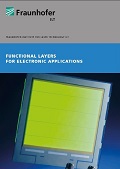
Electronic films are a powerful tool for improving performance of electronic components, adding
functionality and increasing their domain in many areas of modern life.
Fraunhofer ILT develops customized solutions for various applications of such films, utilizing either laser treatments of previously applied thin films or combining printing and laser treatment processes to produce electronic layers.
Due to the digital nature of these technologies, they can be used to process batch sizes from millions (mass production) down to only one (individualized production).
 Fraunhofer Institute for Laser Technology ILT
Fraunhofer Institute for Laser Technology ILT